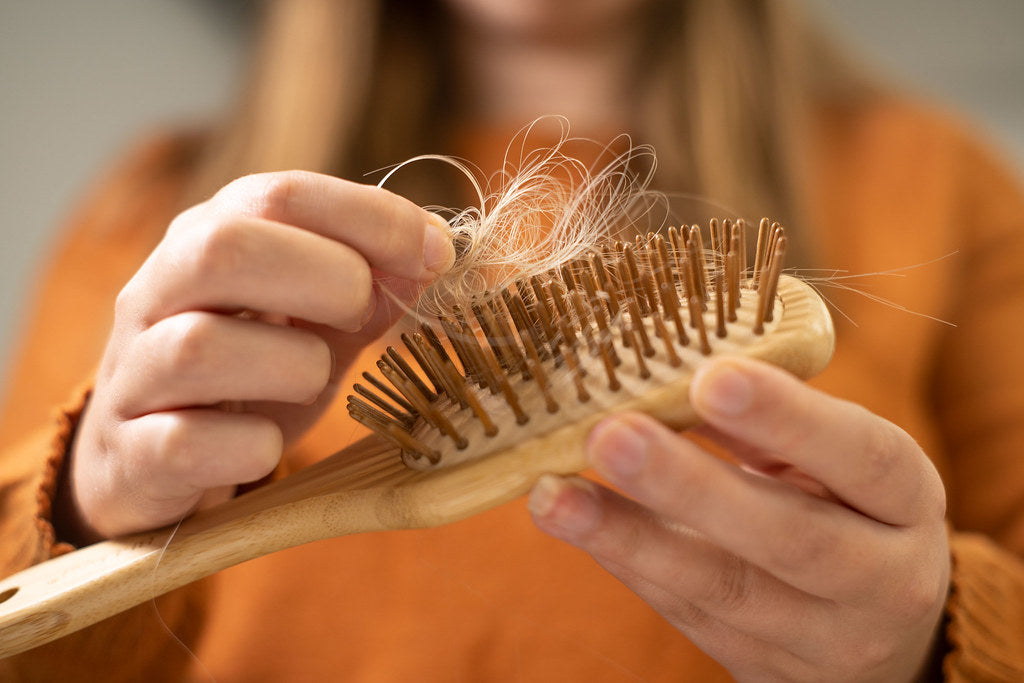
Understanding Postpartum Hair Loss: Causes, Symptoms, Treatments, and Prevention
Share
Postpartum hair loss refers to the shedding of hair that occurs after giving birth. It is a common occurrence experienced by many women and is often temporary. Understanding the causes and impact of postpartum hair loss is crucial for new mothers to alleviate concerns and take appropriate measures for hair care.
Understanding Hair Growth
- Hair Growth Cycle: Hair goes through a continuous cycle of growth, rest, and shedding. Understanding this cycle helps in comprehending postpartum hair loss.
- Factors Influencing Hair Growth during Pregnancy: Pregnancy hormones, particularly estrogen, can prolong the growth phase of hair, resulting in thicker and healthier hair during pregnancy. However, after childbirth, hormonal fluctuations can trigger hair loss.
Postpartum Hair Loss: Causes and Mechanisms
- Hormonal Changes and Hair: During pregnancy, elevated hormone levels prevent excessive shedding, leading to thicker hair. After childbirth, hormone levels decrease rapidly, causing hair to transition from the growth phase to the resting phase, resulting in shedding.
- Telogen Effluvium: Telogen effluvium is the primary cause of postpartum hair loss. It occurs when a significant number of hair follicles prematurely enter the resting phase and subsequently shed.
- Other Contributing Factors: Stress, nutritional deficiencies (such as iron or biotin deficiency), and certain medical conditions can exacerbate postpartum hair loss.
Duration of Postpartum Hair Loss
- Average Timeline: Postpartum hair loss usually begins around three months after childbirth and peaks around four to six months. Hair growth typically resumes within six to twelve months.
- Individual Variations and Factors Affecting Duration: The duration and severity of postpartum hair loss can vary among individuals. Factors such as genetics, overall health, and hormonal balance can influence the duration of hair loss.
Recognizing Symptoms of Postpartum Hair Loss
- Common Signs and Visible Changes: Excessive hair shedding, noticeable thinning or hair loss near the temples or crown, and increased hair on brushes, pillows, or shower drains are typical symptoms of postpartum hair loss.
- Differentiating Normal Shedding: It's important to differentiate postpartum hair loss from other hair loss conditions. While some hair loss is normal after childbirth, excessive or prolonged shedding may indicate underlying issues and require medical evaluation.
Diagnosis and Medical Evaluation
- Consulting a Healthcare Provider: If concerns about postpartum hair loss arise, consulting a healthcare provider is recommended for proper evaluation and diagnosis.
- Diagnostic Tests and Examinations: The healthcare provider may perform blood tests to check hormone levels, assess nutritional status, and rule out any underlying medical conditions contributing to hair loss.
Management and Treatment Options
- Non-Medical Approaches: Hairstyling techniques that create volume and minimize the appearance of thinning hair, maintaining a balanced diet rich in essential nutrients, and adopting a gentle scalp care routine can help manage postpartum hair loss.
- Medical Treatments: Topical solutions containing minoxidil, medications like finasteride (for women not breastfeeding), and supplements (e.g., biotin, iron) may be recommended in certain cases.
- Treatment Impact on the Baby: Most treatments for postpartum hair loss are topical or have minimal systemic absorption, making them safe for breastfeeding mothers. However, consulting a healthcare provider is advised for personalized recommendations.
Preventive Measures for Postpartum Hair Loss
-
Balanced Nutrition: Maintain a well-balanced diet rich in vitamins, minerals, and proteins to support healthy hair growth. Include foods like fruits, vegetables, lean proteins, whole grains, and healthy fats in your meals.
-
Stress Reduction: Manage stress levels through relaxation techniques, regular exercise, and activities that promote mental well-being. High stress can contribute to hair loss, so finding healthy ways to cope with stress is important.
-
Gentle Hair Care: Use gentle hair care practices to minimize hair damage. Avoid excessive heat styling, tight hairstyles, and harsh chemical treatments. Opt for wide-toothed combs or brushes with soft bristles to prevent hair breakage.
-
Scalp Care: Keep your scalp clean and healthy by washing it regularly with a mild shampoo. Avoid using harsh products that may strip the scalp of its natural oils. Gently massage your scalp to stimulate blood circulation.
-
Protect from Environmental Damage: Shield your hair from environmental stressors such as sun exposure, pollution, and harsh weather conditions. Wear hats or use protective hair products with UV filters when exposed to the sun.
-
Avoid Overprocessing: Minimize the use of chemical treatments, such as perming, relaxing, or coloring your hair, especially during the postpartum period. These processes can weaken the hair shaft and contribute to hair loss.
Outlook and Regrowth Expectations
- Will Hair Grow Back: In most cases, hair does grow back after postpartum hair loss. The hair growth cycle resumes its normal pattern, and new hair replaces the shed hair.
- Factors Influencing Regrowth: Individual factors such as genetics, overall health, hormonal balance, and postpartum care practices can influence the regrowth process.
- Patience and Self-Care: It is important to be patient and allow the hair to go through its natural regrowth process. Practicing good hair care, managing stress, and maintaining a healthy lifestyle can support regrowth.
Living with Postpartum Hair Loss
- Psychological and Emotional Aspects: Postpartum hair loss can be emotionally challenging for some women. Understanding that it is a temporary condition and seeking support from loved ones or support groups can help alleviate distress.
- Seeking Support and Connecting with Other Women: Connecting with other women who have experienced postpartum hair loss can provide a sense of community and shared experiences.
- When to Consult a Healthcare Provider: If postpartum hair loss is causing significant distress, if hair loss is excessive or prolonged, or if there are other concerning symptoms, it is advisable to consult a healthcare provider for further evaluation and guidance.
Conclusion Postpartum hair loss is a common occurrence experienced by many women after childbirth. Understanding the causes, duration, and management options can help alleviate concerns and promote healthy hair growth. By implementing preventive measures, seeking support, and practicing self-care, women can navigate through postpartum hair loss with confidence and empower themselves with knowledge for optimal hair health.
